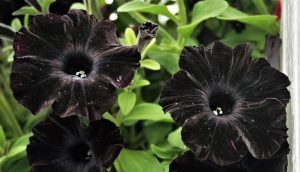In keeping with our recent master gardener articles about garden planning that takes place in the fall, I would like to relate my experience with petunias-as-more-than-annuals.
In May and June petunias have a period of vigorous growth and my love affair begins. Each year I struggle with deciding which color of beautiful trailing petunias in their hanging baskets to take home. This year I found the most beautiful basket of creamy lavender flowers. After hanging it in my garden and hooking it up to my drip irrigation system, I was out daily checking on it and pulling off spent blossoms.
Even with this attention my plant started to get leggy. I wanted to stimulate new blooms, so chose to prune above a leaf node somewhere back down the leggy stem. I have a hard time cutting back blooms. I can hear them say, “No, no not me!” If the old blooms are not removed, the plant will work at producing seeds for plant survival. After pruning, I did see some increase in blooms at the various pruning sites but it was not the lush flowering effect I wanted.
I then went to propagation mode. Cutting back several dozen leggy branches, I picked the greenest and healthiest dozen ones. Stripping the leaves off the lower three to four inches of each branch, I removed any blossoms. Then I dipped the stripped end in powdered rooting hormone and planted each division into its own cell in rooting soil in one of those multi-celled plant-starting containers. Days passed and, with regular watering, at least half of the branches survived. I continued to prune the plant, not hearing as much of the “no, no not me.” (Either the mother plant was happy that I had some survivors or I felt less guilt by doing due diligence and keeping the transplants alive.)
If you decide to try this technique, I would recommend starting the pruning process earlier. Be more aggressive. Prune back the stem by a third to a half on at least half the stems. The node just below the pruning cut will send out two blooms where cut, keeping the basket full.
Another alternative is to cut back less length, but more branches. This would create a period of time without blooms while new growth is occurring. My propagated branches took several weeks to produce a new bloom.
I do know this propagation experiment is continuing and I’m grateful it has gone so well. This flower color is my absolute favorite, so next year I will try harder with more alternatives. Will cutting each pruned branch in two create more survivors or fewer?
I’m transplanting the cuttings into a larger pot with seed starting soil. I will be careful to keep the soil moist and allow it to overwinter between the garage and a sunny window sill. I’m definitely not as hesitant to keep working on this adventure and may continue to take cuttings throughout the winter, depending on how much growth occurs. We shall see what next spring brings; these petunias do so well in my back patio in Zone 9.
Diane Miller is a University of California Cooperative Extension Master Gardener of Tuolumne County.

